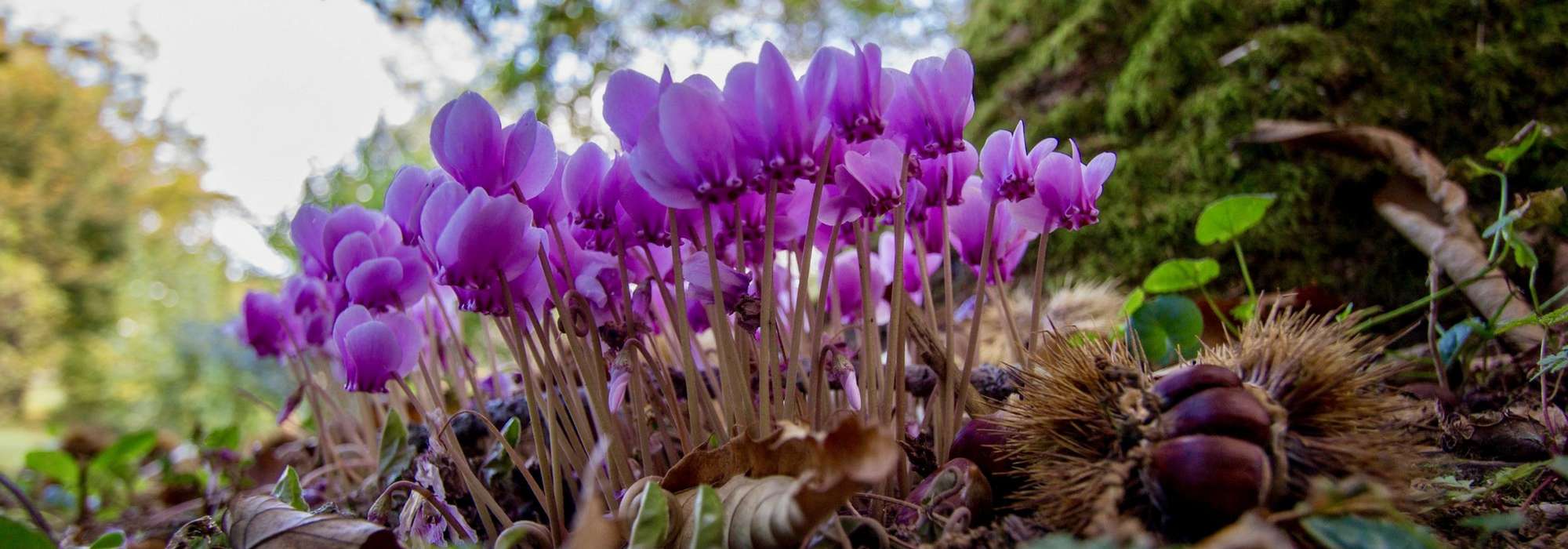
Cyclamen: planting, growing and care
Contents
Cyclamen in a nutshell
- Cyclamen are delightful little bulbous plants whose flowers bloom in late winter or late summer
- The foliage is just as decorative as the flowering
- In pots, as well as in borders, they thrive in shade
- Cyclamen easily naturalise to form beautiful colourful carpets
A word from our expert
Cyclamens hide their true nature behind their delicate appearance. We adore them for their dainty, upturned flowers that come in charming shades of pink, magenta, or white, reminiscent of little opera rats… But don’t be fooled by their looks: they are robust plants that are very easy to grow. They thrive in partial shade, in areas that can be challenging to plant, and proudly add colour during the least flowery months of the year.
Cyclamens are essential for bringing colour and freshness during the dreary season. The beauty of their foliage alone justifies their cultivation: it features lovely variations of green and silver patterns. Moreover, their elegant leaves provide winter cover for beneficial insects in the garden.
Adaptable, they also delight urban gardeners: they grow very well in pots, indoors for florist cyclamens, or outdoors for other species, on balconies or terraces. They create lovely winter displays, adding splashes of colour against delicately variegated foliage. Endearing and graceful, cyclamens have an irresistible charm!
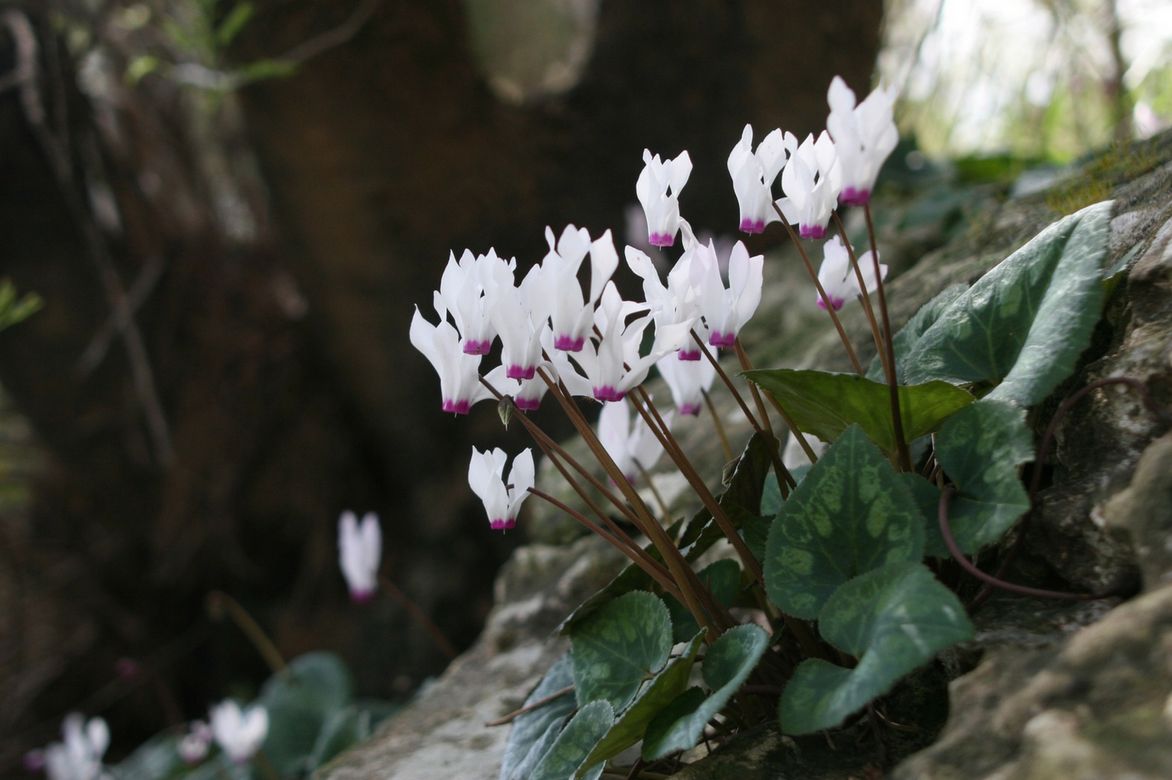
Superb flowering of cyclamens.
Botany
Botanical data
- Latin name Cyclamen
- Family Primulaceae
- Common name cyclamen
- Flowering from August to May, depending on the varieties
- Height from 10 cm to 35 cm
- Exposure partial shade or shade
- Soil type all well-drained soils
- Hardiness -15°C
Small tuberous perennials, cyclamens are among the easiest wildflowers to grow. Although native to Mediterranean countries, they thrive in any well-drained, rich soil. Hardy, they can withstand temperatures down to -15°C, except for the tender Cyclamen persicum. They belong to the family Primulaceae, which includes herbaceous plants from temperate regions of the Northern Hemisphere.
The leaves are simple, without stipules, and form a rosette at the base of the stem. The flower stalk is leafless. Cyclamens have fleshy, leathery foliage that is heavily veined in lighter green, even silver. The underside is reddish-purple, and the petiole is green-pink, creating a beautiful colour harmony of green, pink, purple, and silver.
The flowers come in a wide range of colours: red, magenta, pink, and white. They consist of 5 tepals that are reflexed backward and fused at their base. In the centre, the flower may feature a darker macule, which is very decorative.
The beauty of their foliage and flowers is undeniable, but their appeal also lies in the fact that their flowering occurs during the “quiet” periods of the garden, from autumn to spring.
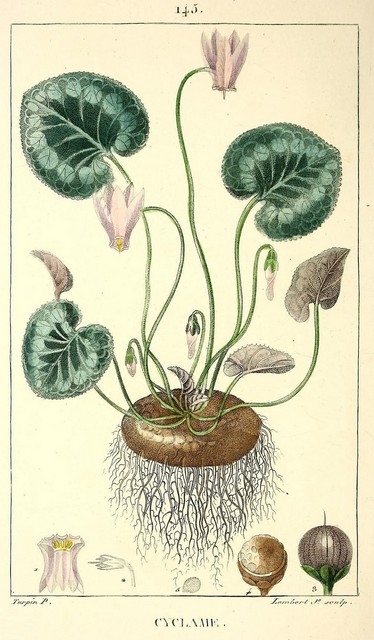
Cyclamen – botanical illustration
The flowering period varies depending on the species. From January, C. coum braves the frost to bloom until March-April. C. pseudoibericum takes over from March to May (but the leaves are already present since the end of the previous autumn). The Naples cyclamen blooms at the end of summer, from late August to September, followed by C. cilicicum, from September to November.
Generally, the foliage is present in winter, displaying beautiful colours that are always welcome in a bare garden at this time of year. However, most cyclamens enter dormancy in summer and disappear during the hottest periods.
There are many species of cyclamens. They are often less hardy and difficult to maintain, which is why only the varieties coum, hederifolium, pseudoibericum, and cilicicum should be preferred for outdoor cultivation. Cyclamen persicum has produced many hybrids with larger flowers, but it is sensitive to cold, so it should be reserved for indoor cultivation.
After fertilization, the flower stalk twists like a corkscrew towards the ground, creating amusing spirals at the base of the plants. The seeds are covered in a mucilage that ants love. They carry them into their nests and discard the naked seed once the sugary substance has been consumed. Germination occurs within the year, and the seedlings will take 2 to 3 years to flower. This is how cyclamens gradually form vast and magnificent vegetative carpets.
Over the years, the naturalised tuber becomes enormous (the size of a plate!), resulting in increasingly voluminous plants. These bulbs do not develop bulblets and do not divide. Only sowing allows for propagation. The tuber is toxic.

The foliage of cyclamens is very decorative: Cyclamen hederifolium ‘Album’, Cyclamen coum, Cyclamen coum ‘Silver White’, Cyclamen neapolitanum.
Read also
How to sow cyclamen?The main varieties of cyclamen
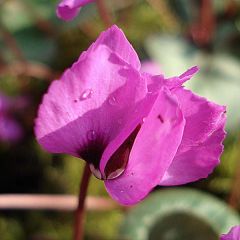
Cyclamen coum
- Flowering time March, April
- Height at maturity 10 cm
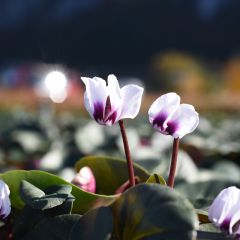
Cyclamen coum Album
- Flowering time March to May
- Height at maturity 10 cm
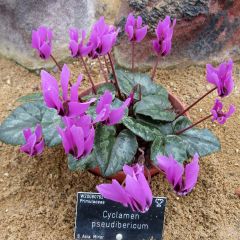
Cyclamen pseudibericum
- Flowering time February to April
- Height at maturity 15 cm

Cyclamen persicum - Persian Cyclamen
- Height at maturity 30 cm
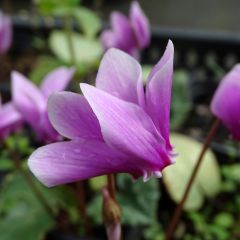
Pink Naples Cyclamen
- Flowering time September to November
- Height at maturity 15 cm
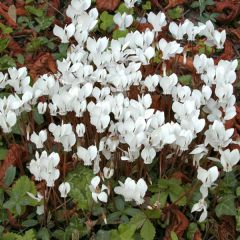
Cyclamen hederifolium Album
- Flowering time September to December
- Height at maturity 10 cm
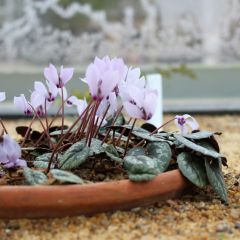
Cyclamen cilicium
- Flowering time October to December
- Height at maturity 10 cm
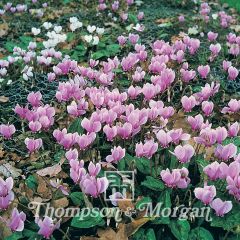
Cyclamen All The Year Round Flowering Mix - Garden Cyclamens
- Height at maturity 15 cm
Discover other Cyclamen
View all →Available in 1 sizes
Available in 4 sizes
Available in 1 sizes
Available in 3 sizes
Available in 1 sizes
Available in 1 sizes
Available in 1 sizes
Available in 1 sizes
Available in 1 sizes
Available in 1 sizes
Planting cyclamen
Cyclamens are available in buckets or as tubercles. The tubercle is flat, which may confuse the novice gardener! To determine the planting orientation, take a closer look at the tubercle: you will notice a slightly bulging part, which should be placed underneath (the flat part will therefore be on top…).
Where to plant cyclamens?
Cyclamens prefer shade or partial shade and well-drained soil, especially during their vegetative rest period, usually in summer. Any well-drained and humus-bearing soil will do. In a rockery, at the foot of deciduous trees or a hedge, even where few plants thrive, the cyclamen will establish itself durably.
On a terrace or balcony, the cyclamens in pots will be exposed to partial shade.
Indoors, pots should be placed away from a heat source and in a well-ventilated and bright room, without direct sunlight.
When to plant cyclamens?
Plant cyclamen tubercles during the summer, during the dormancy period. Cyclamens offered in buckets can be planted whenever desired, except in the heart of winter when the soil is frozen. If necessary, soak the dry tubercles in water for 10 minutes to rehydrate them.
In the ground
- Work the soil to a depth of 8 to 10 cm with a spade
- Add a bit of potting soil or compost and gravel, sand, or pumice in heavy and wet soil in summer
- Plant your tubercles flat side up at a depth of 3 to 5 cm
- Water moderately
In pots
For a pot with a diameter of 40 cm, plan for 2 to 3 tubercles. The plants in buckets should be soaked in a basin of water to improve their recovery.
- Place shards over the drainage hole
- Add gravel, pumice, or clay balls to improve drainage
- Add the potting soil
- Plant your tubercles at a depth of 3 to 5 cm (or the previously hydrated buckets)
- Water moderately
Also, check out our tutorial How to sow cyclamens?
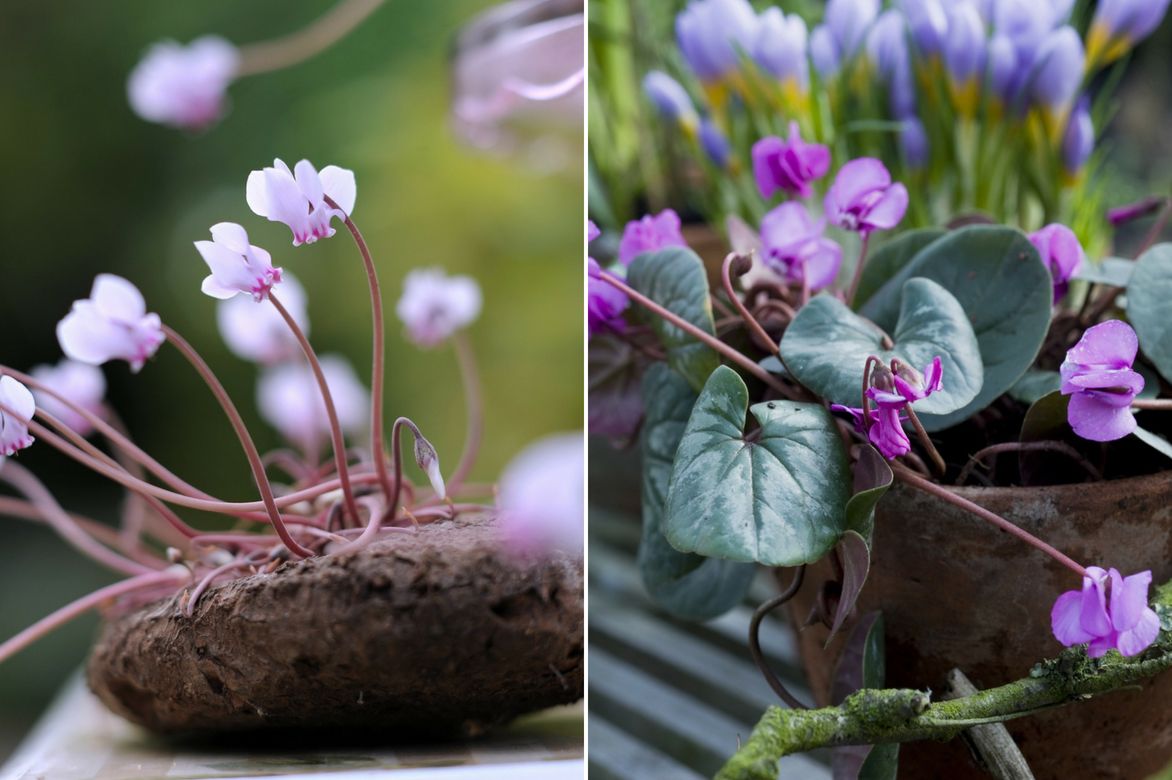
Flat tubercle of Cyclamen / Cyclamen in pot (ibulb)
Caring for Cyclamen
Botanical cyclamens (coum, hederifolium…)
Very robust, cyclamens planted in the garden require no special care. Careful planting, that is to say in light, well-draining soil that is not waterlogged in winter, will prevent any rot of the tubercles.
In pots and outdoors, in case of winter drought, moderate watering is necessary. Wait for the substrate to dry and water at the base of the plant without wetting the leaves. When the bulbs enter dormancy, dig up the bulbs and dry them for storage in a cool, dry place.
Cyclamen persicum and its hybrids
A reasonable warmth, around 18°C, and a bright location should be sufficient for your cyclamen to thrive. As it is a woodland plant, direct sunlight should be avoided. Ideally, take it outside on days when it is not freezing and bring it back in at night.
Moderate watering will be welcome and cutting off faded flowers extends the flowering period. Be sure to gently pull the peduncle from the tubercle to avoid rot.
To prevent diseases, place the plant in a well-ventilated area. Cut the leaves as soon as wilting or yellowing appears.
Diseases and Pests
Outdoor cyclamens are robust and less prone to diseases.
Florist cyclamens are sensitive to botrytis, or grey mould. A well-ventilated location prevents the spread of this fungus.
Fusarium wilt is equally formidable, attacking the tubercle and causing the leaves to yellow. A confined and warm atmosphere (25°C) promotes the proliferation of this fungus. An excess of nitrogen (fertiliser for green plants, for example) is equally detrimental.
Propagation
Cyclamens propagate easily by sowing. In the wild, they colonise vast areas thanks to their numerous seeds, also aided by the appetite of ants. You can therefore collect the seeds and germinate them in buckets or sow them directly in place. They will quickly produce young plants that will not flower until 2 or 3 years after sowing.
Association
Used as ground cover, for a woodland area or at the foot of a hedge, cyclamens can be paired with primroses or violas, small perennials that flower at the same time. Snowdrops or muscari will also make good companions.
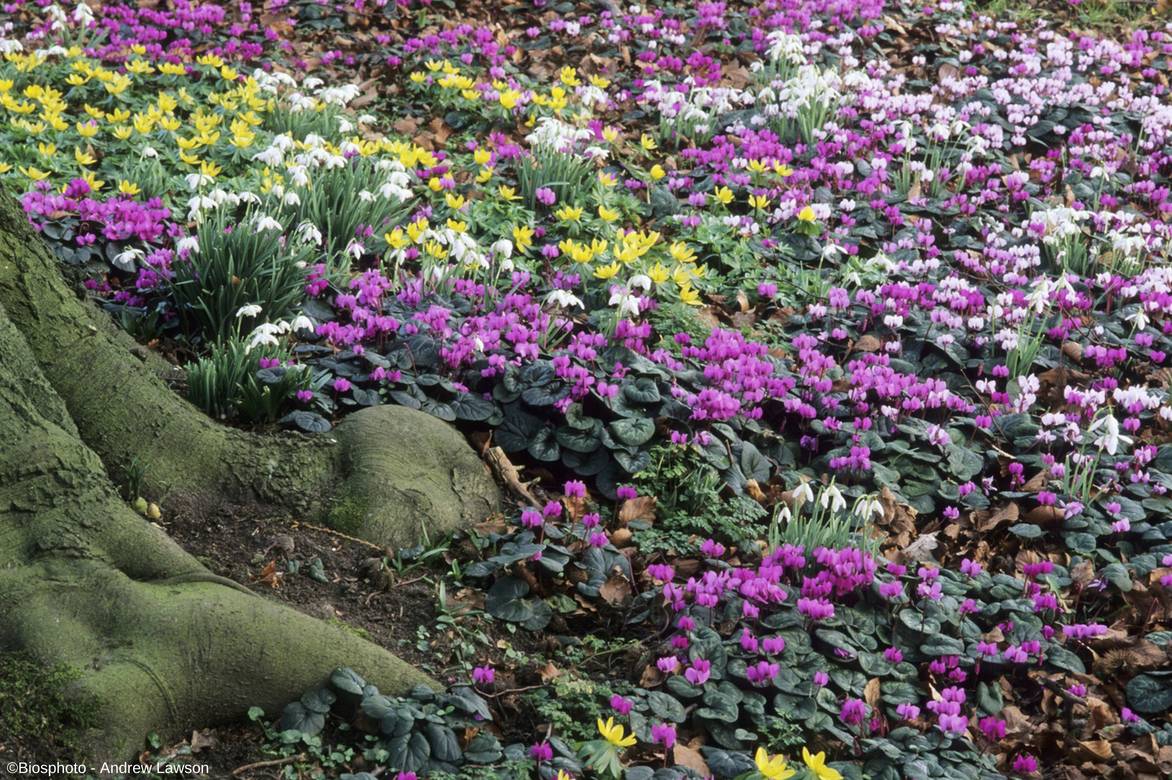
An example of a woodland association: Cyclamens, Snowdrops (Galanthus), Eranthis hyemalis.
For a fresh and vibrant effect, white cyclamen coum, paired with yellow pansies, accompanied by white heather and a pale yellow hellebore will look stunning on a balcony or in a rockery.
A beautiful winter pot is described in this short article by Ingrid.
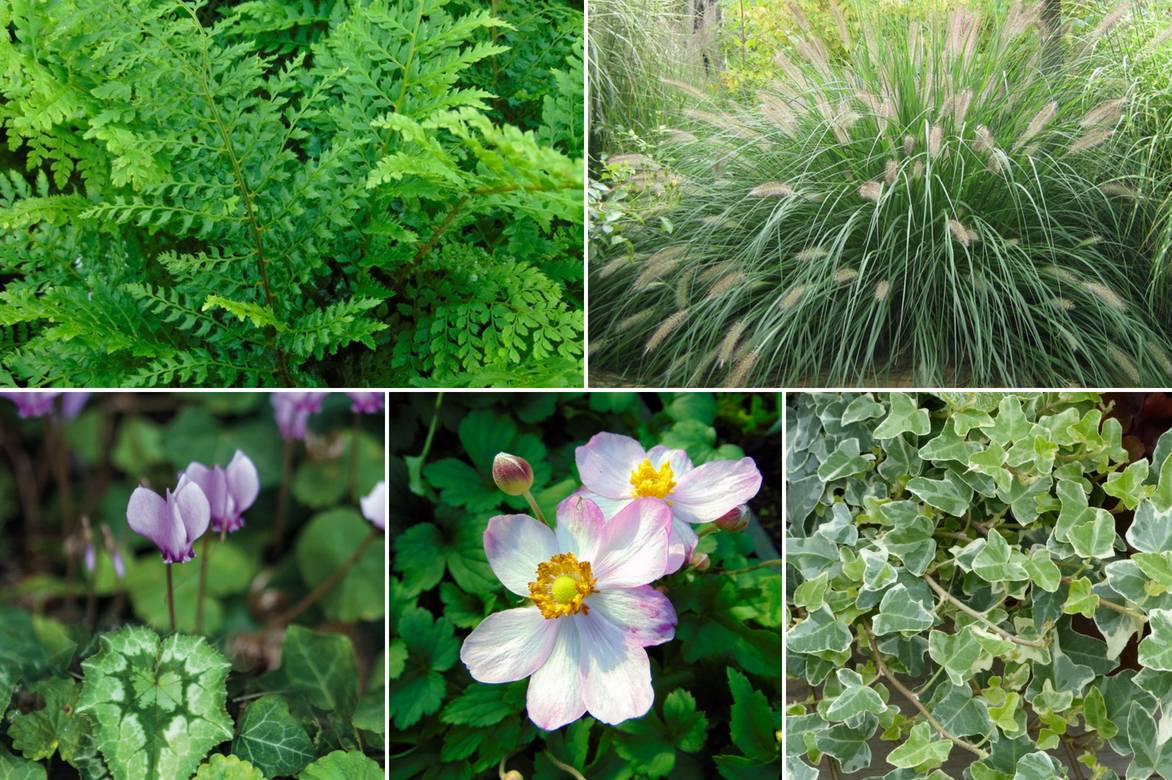
An example of an association in a large pot: Polystichum setiferum ‘Proliferum’, Pennisetum alopecuroides ‘Gelbstiel’, Cyclamen hederifolium, Anemone japonica ‘Fantasy Cinderella’, Hedera helix ‘Mini Ester’.
For autumn, dwarf asters and a blue fescue will highlight cyclamens of Naples at their feet.
Discover other plants that will accompany your cyclamens in autumn and late winter.
Useful resources
-
- Discover our range of cyclamens!
- Check out our 7 ideas for creating beautiful summer planters
- Bulb size: understand to choose better
- Our advice sheet: how to grow Naples cyclamens in pots?
- Discover our ideas and inspirations for pairing cyclamens in the garden.
- Find out about 7 bulbs for late summer and early autumn flowering
- Our advice sheet: How to grow florist’s cyclamen?
- Marion’s tips in Brighten up shady areas with spring bulbs!
Frequently asked questions
-
I was given a flowering cyclamen. Should I put it outside?
It is likely that you have been given a florist's cyclamen. This variety being sensitive to cold, it is better to keep it indoors when it freezes. Place it away from any heat source and a window. Water moderately without wetting the leaves and remove the stems of faded flowers. It should flower from September to May! When the leaves disappear, the plant is in a dormant phase. Store the pot in a cool, dry place and resume watering at the end of summer to see your cyclamen reappear. A little low-nitrogen fertiliser once a month will maintain the flowering.
-
I have a potted cyclamen on the terrace window for several years. It is thriving so much that it has become huge. I would like to share it by putting half of it in another pot. How do I divide my cyclamen?
Cyclamen tubercles do not divide! To multiply them, you need to collect the seeds and sow them in a bucket filled with sowing compost. When the tubercle is very large, simply repot it into a larger pot, ensuring that the convex part of the bulb is facing down (the flat part is always facing up).
-
I planted cyclamen for the first time at the end of last summer. Can I leave them in my garden all year round?
Cyclamen are hardy and can withstand low temperatures (down to -15°C). Towards the end of spring (a little earlier for certain varieties), cyclamen enter a vegetative rest for the summer. They emerge again at the end of summer, during autumn or winter, depending on the species. It is best to leave them in place to see them spread and enjoy their magnificent foliage and delicate flowering.
- Subscribe!
- Contents
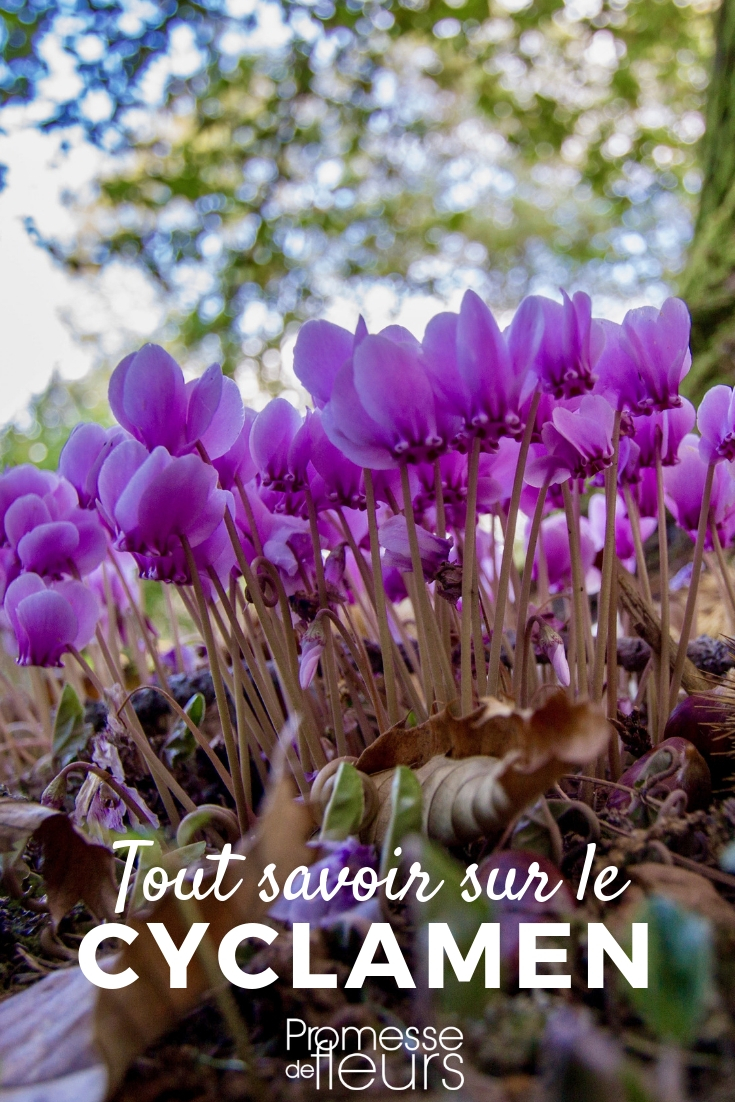


































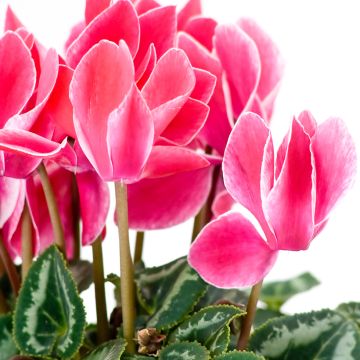

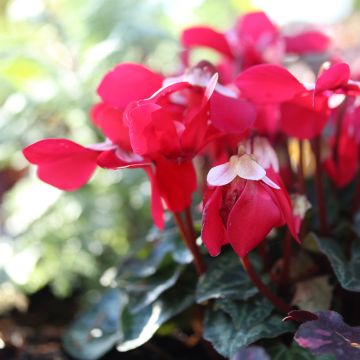
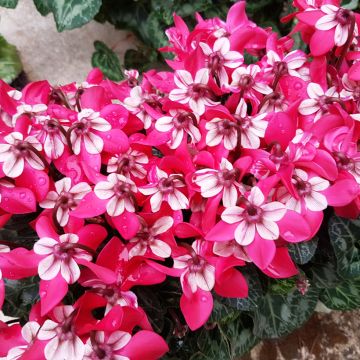
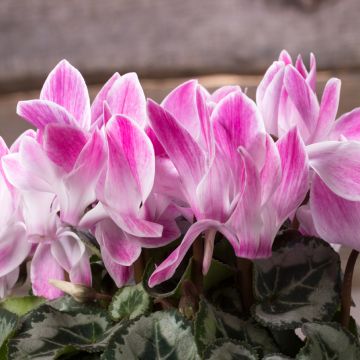
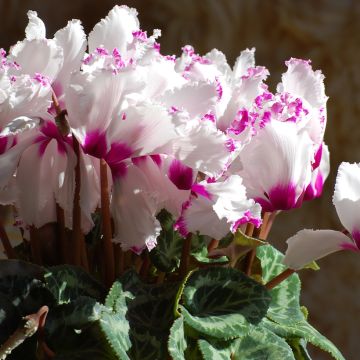
Comments